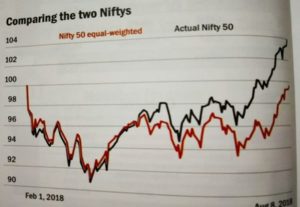Last month, I was in Jaipur to give a finance training. I met one of my friends there who is an avid equity investor. Over a cup of coffee, he began to pour his heart out, and giving voice to an agony which millions others behold ‘How come the market (Nifty) is at all time high while my stocks are so low, many perhaps in negative’? I had limited time at my disposal as I had to catch up with the training program. So, I didn’t explore the technicalities and had nothing much to say to him other than a few words of consolation.
What is the reason that despite the Nifty hitting new highs, most investors are grumbling that their portfolio is losing its value.
Well, the reason is the way the Nifty is actually constructed.
The Nifty that we are talking about is an index consisting of a pack of 50 companies with the highest market capitalisation. The market capitalisation is defined as total no of shares that are being traded multiplied by current market price per share. Now, Nifty is a market-weighted index. In the sense, the higher the market capitalisation of a stock, greater would be the impact of that stock’s increase or decrease, on the Nifty. Let me explain with a small numerical example
Suppose, you calculate the market capitalisation of each of these 50 companies in Nifty. You simply add up the total and get, say, Rs 50,000 crores. Suppose the market capitalisation of the topmost company in Nifty (ABC Ltd) is, say, Rs.10,000 crores. This means that 20% of the index has the impact of ABC Ltd. Similarly, the impact (weight) of each stock in the Nifty can be calculated.
So what is the implication. It simply implies, that if the stocks having the greatest weight in Nifty goes up, the Nifty will go further up, without the other components of Nifty moving too much. In simpler words, only a few companies in the Nifty would have a real “say” in the matter, when the Nifty as an index goes up or down.
One classing example I would like to quote is a comparison between Tata Motors and HDFC Bank. Tata Motors is there in the Nifty Index. Since February 2018, it has fallen big time. However, if we look at the Nifty as such, the impact is negligible, almost non-existent. Whereas HDFC bank has quite a big weight in the Nifty, and it has risen since February 2018 and we can clearly see how successfully it has managed to pull the Nifty up.
So, is there any way where we can overcome this ‘non-sensical’ behaviour of Nifty and have a more rationalised index to make investment decisions. The answer is Nifty itself. Yes. If we construct Nifty with an ‘equal weight’ approach rather than the popular ‘free float’ approach, the index would be somewhat closer to reality, though some discrepancies still persist.
(Source: Value Research)
The graph suggests that if the companies in the Nifty 50 index were weighted equally, the market would have actually fallen since 31st January. This means that whatever upward rally we are seeing in Nifty is just because of some few stocks which drive the Nifty
Personally, I have never been a fan follower of Nifty. Its always better to focus more on individual stocks rather that on indices like Nifty which are inherently biased in its construction. It doesn’t matter whether you are a technical trader or a fundamental investor, its wiser to track companies and the individual stocks. Indices can be observed just as a supporting indicator.
CA Sarvesh Mopkar
(Sarvesh Mopkar is a member of the Institute of Chartered Accountants of India. He has been a professor of finance and has been a freelance trainer with various reputed Business colleges. He is passionate about financial planning and equity research and has been training in that domain for over 8 years.)


